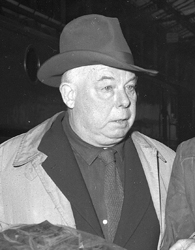Lauded after his death as one of cinema’s greatest directors, Jean Renoir earned comparatively few words of praise during his lifetime. From a childhood in Montmartre, sitting as a model for his famous Impressionist-painter father, to a Best Director Oscar nomination for his 1945 film “The Southerner,” Renoir’s creativity carried him through a colorful life.
Jean Renoir’s Early Days
Born in Paris on September 15, 1894, to renowned Impressionist painter Pierre-Auguste Renoir, Jean Renoir’s childhood was ruled by his father’s artistic passions.
“My father loved to paint my hair, and his fondness for the golden ringlets which came down to my shoulders filled me with despair,” Jean Renoir wrote in his 1974 autobiography.
“At the age of six, and in spite of my trousers, many people mistook me for a girl…I impatiently awaited the day when I was to enter the College de Sainte-Croix, where regulations required a hairstyle more suited to middle-class ideals. To my great disappointment my father constantly postponed the date of my entry, which for me signified the blissful shedding of those locks.”
Sources in this Story
- Britannica Online Encyclopedia: Jean Renoir
- Senses of Cinema: Jean Renoir
- Chicago Public Radio: Jean Renoir’s “The River”
- Fathom (via Archive.org): Jean Renoir on Actors and Audiences
- IMDb: Awards for Jean Renoir
- Wellesnet (Los Angeles Times): Jean Renoir: ‘The Greatest of All Directors’
- YouTube: Rules of the Game Trailer (Jean Renoir, 1939)
Renoir’s Notable Accomplishments
After a crash landing forced his retirement from the French Air Force, Renoir began making films, writing parts for his girlfriend and future wife, Catherine Hessling. Renoir financed his films by selling his father’s artwork and ended up in the director’s chair after disagreements with directors marred his early films.
He worked in both silent films and those with sound, in black-and-white and color; he was one of the few directors who didn’t fight the transitions. Renoir constantly pushed the limits of film technology and was among the first to film outdoors and capture scenes with multiple cameras.
In addition to his technical skills, Renoir’s films also showcased his deep understanding of human interaction. His characters were complicated and their desires were on full display; he didn’t shy away from more difficult themes, as was the custom in the early days of cinema.
While his most famous work was probably “Grand Illusion,” Renoir directed, wrote or acted in more than 50 films during his career. Most of his films were in French, but he lived in the United States for a period in the 1940s and during that time directed several English-language films such as “The Southerner,” “The River” and “The Woman on The Beach.”
Renoir’s work received frequent criticism, but the director shrugged it off, saying the critics were too old to relate to his films. “I have basically one audience in the world, people under 20, kids. You know, very often I have insisted to my producers to put a sentence on the marquee so the film could be forbidden to people who are more than 20. How you say in English? Adults only? I would say: ‘Children only.’”
Despite his detractors, Renoir did garner some acclaim: In 1937, he won an International Award for “The River” at the Venice Film Festival; 1946 brought him an Oscar nomination for Best Director for “The Southerner” and he accrued a smattering of other local film honors.
In 1975, Renoir was awarded an Honorary Oscar for his work as “a genius who, with grace, responsibility and enviable devotion through silent film, sound film, feature, documentary and television has won the world’s admiration.”
Renoir and his Work
- “Jean Renoir: 3-Disc Collector’s Edition” (DVD)
- “The Rules of the Game” (DVD)
- “Grand Illusion” (DVD)
- “My Life and My Films” (Book)
- “Renoir, My Father” (Book)
The Rest of the Story
After Renoir died on February 12, 1979, Orson Welles eulogized him in the Los Angeles Times, calling him the “greatest of all directors.” In it, Welles complained of the ill-treatment Renoir received from both the French and American film industries and the general viewing public.
In 2006, Janus Films rereleased “The Rules of the Game,” complete with recovered footage originally edited out in its original release. Through a complicated plot, Renoir lampoons upper-class society with characters who take a trip to the country, participate in mad love affairs, double-cross each other and ultimately scheme a murder. The film was nearly universally disliked in 1939, but is now hailed as “one of the greatest films ever made.”
This article was originally written by Jennifer Ferris; it was updated September 4, 2017.











